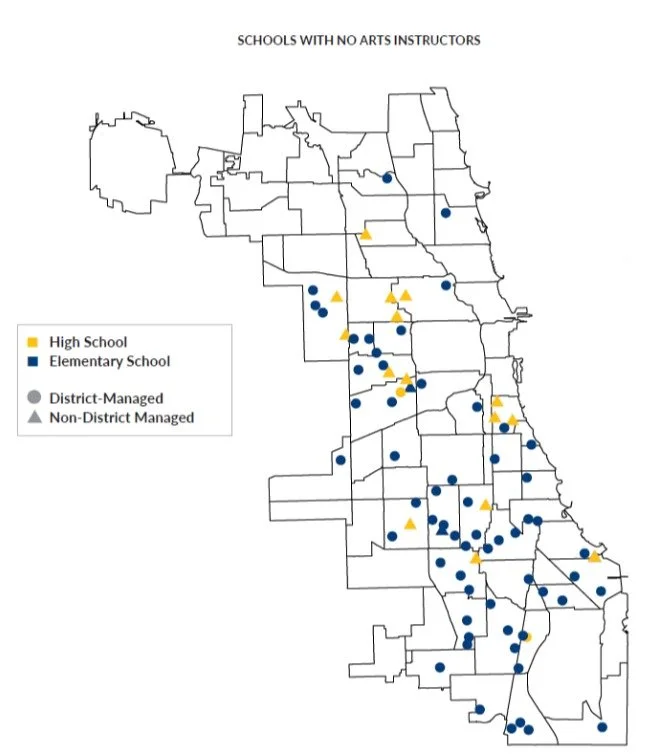
News
Spotlight: our Arts Learning Program
Mar 10, 2025
Expanding access to arts education and an update on student engagement
The longstanding goal of the Lloyd A. Fry Foundation’s Arts Learning program has been to improve access to high-quality arts learning experiences for low-income youth in Chicago Public Schools (CPS).
How far we’ve come
Over the last fifteen years—despite some ups and downs—Chicago Public Schools and the nonprofit arts sector has maintained its shared commitment to providing arts education for all students. Of course, universal access to arts learning has yet to be achieved. But CPS and Chicago’s arts community continue to work together to create policies and practices that drive us towards arts for all CPS students. Critical to achieving this goal is an ongoing commitment to gathering data to help CPS and arts partners decide how and where to target resources like art teachers and arts partners, and how to improve the quality of arts instruction.
In the 2022-2023 school year…
69% of CPS schools rate as Excelling or Strong in the arts
393 arts organizations work with 568 schools
CPS employs 1,141 art teachers
With improved data gathering and reporting, Chicago has a much clearer picture of the state of arts education. Annual data gathered and used by the CPS Department of Arts Education and Fry Foundation grantee Ingenuity identifies both progress and gaps in arts instruction. This allows CPS and arts partners to target individual schools for extra supports. For example, data from Ingenuity’s 2023 State of the Arts report showed that the distribution of arts teachers across the district remains uneven. While some schools place the arts as a high priority and have multiple art teachers on staff, approximately 65 CPS schools still do not have a single art teacher. To address this uneven distribution of arts instruction, CPS adopted a position-based funding model, allocating at least one art teacher per school.
How the Fry Foundation grantmaking contributes to Arts Learning in Chicago:
Our funding strategy is centered around two main areas, supporting direct arts instruction and teacher professional learning.
The Foundation invests close to $1.5 million annually in 40 arts and cultural organizations working in Chicago.
In 2025, Fry Foundation Arts Learning Grantee Partners anticipate serving 55,000 students in 311 schools. This represents 49% of all CPS schools.
In addition, grantee partners work with 20 community sites and four hospitals.
Of the students supported by Fry Foundation grantees, 47% are Spanish speaking, 35% are Black and 80% are living in low-income families and communities.
What’s next? Building long-term relationships with underserved schools and improving student engagement in arts learning
Foundation staff regularly engages grantees in discussions to share ideas and understand emerging opportunities. There are two themes emerging from these conversations. First, there is an opportunity to help grantees build and sustain long-term relationships with schools that continue to lack access to the arts. Secondly, support curriculum development and professional learning to help programs improve student engagement in arts lessons.
We look forward to exploring these emerging areas and continuing to support our grantees as they advance arts learning for Chicago students.
Build and sustain relationships with underserved schools
Despite increased access to arts programming for many schools, we know gaps persist. This can be found especially among CPS schools with low enrollment and high percentages of low-income students, as well as in charter schools. These schools often struggle to offer consistent arts programming due to competing budget priorities or limited partnerships with arts organizations. As many as 65 CPS schools have no access to arts instruction. To address these inequities, the Fry Foundation has prioritized support for organizations who have innovative approaches to reach underserved schools and communities. Programs like Forward Momentum, West Point School of Music, and South Chicago Dance Theater exemplify organizations prioritizing historically underserved areas of Chicago. These programs were smaller and newer when they entered the Arts Learning portfolio, but they were able to reach schools that have limited access to the arts. They have demonstrated their ability to build long-term relationships that allow for students to continue to participate in the arts as they progress from grade to grade.
In the coming year, we want to continue to learn with grantees, both large and small, about the strategies and challenges they are facing when reaching schools with limited access to the arts. We will also explore with school leaders the obstacles they face in establishing and sustaining arts programs.
Increasing student engagement
Research from the University of Chicago, Harvard, and Stanford identifies conditions for learning that improve student engagement levels and positive academic outcomes. These conditions are important to all types of learning—including arts learning. These conditions affirm students’ identities, create a sense of community, and offer meaningful, relevant work and are more likely to deepen engagement. Additionally, providing students with opportunities for agency and voice in their learning processes enhances their connection to the material. While student achievement and demonstration of arts skills are important indicators of a high-quality program, we are also learning that the process of student learning and the environment in which students learn are critical to creating a positive experience for students. Our strongest Arts Learning programs incorporate approaches that aim to increase student engagement in meaningful and rigorous artmaking activities. The challenge lies in measuring engagement at the program provider level and helping art teachers and teaching artists adjust teaching methods to support highly engaging arts learning experiences.
In the coming year, we will continue to learn from our grantee partners and share emerging and established best practices in arts education.

